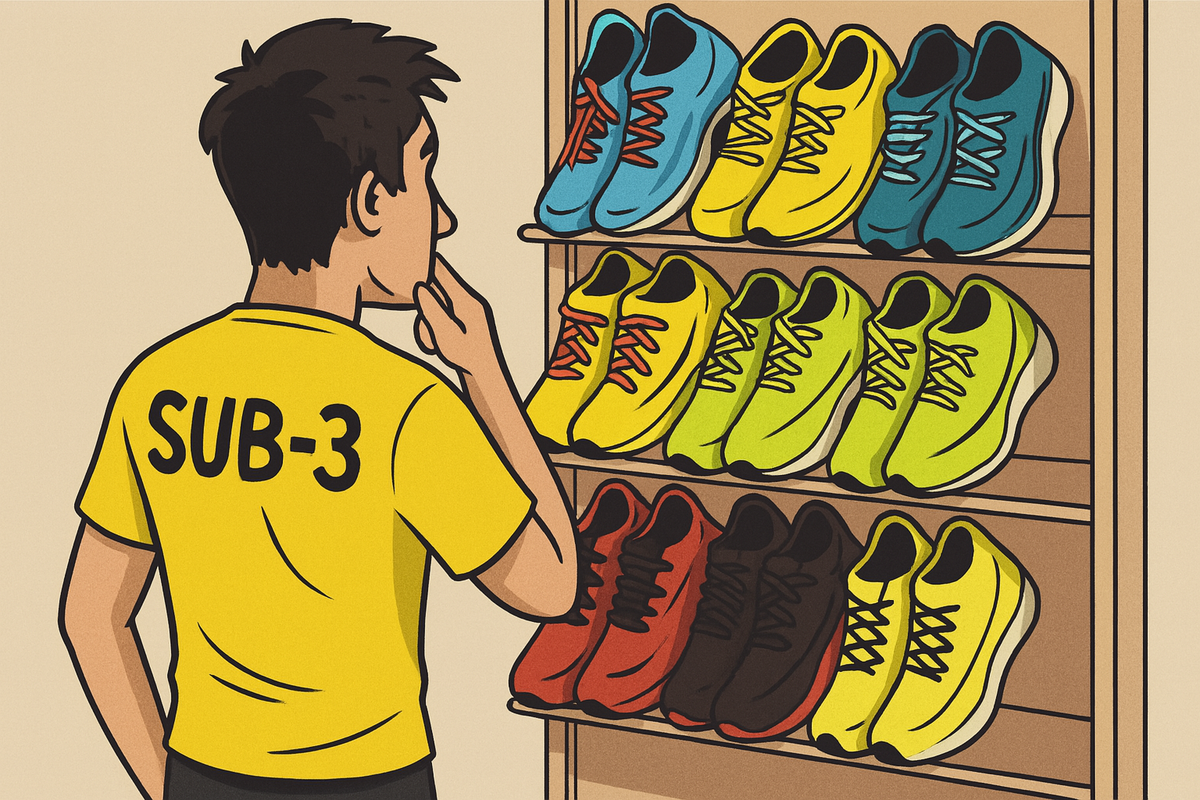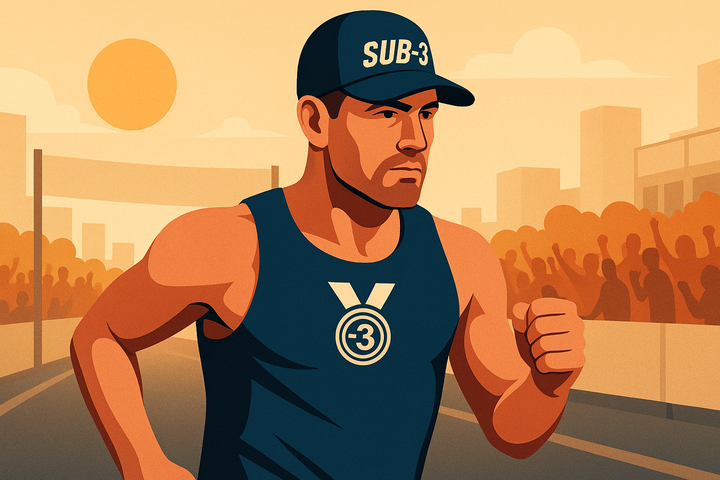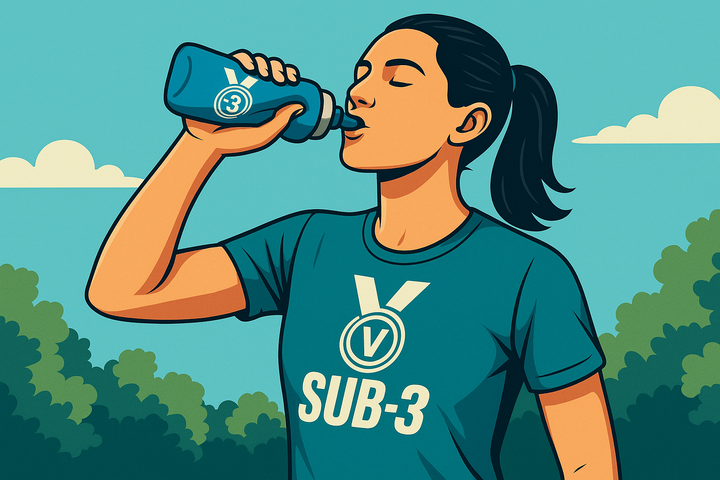How many shoes should a sub-3 runner have in rotation?
Rotating your running shoes isn’t just about indulgence or kit obsession. For sub-3 runners, it’s a practical strategy for injury prevention, cost control and performance.

Some questions sound simple until you ask a serious runner. “How many shoes should I have in rotation?” is one of those. The honest answer? It depends. But for many chasing sub-3, it’s likely to be more than they’d like to admit.
For me, during a marathon training block, I typically have around eight pairs in rotation. That includes my day-to-day workhorses, carbon-plated tempo shoes, a cushioned recovery option, one trail shoe for grip and a couple of specialised racing pairs. I won’t say how many are in storage - suffice to say it’s a multiple of that. I’m a bit of a hoarder, especially when a much-loved shoe stops being produced. I also find it hard to part with shoes that still have some life in them, especially when they’ve been well broken in (although when I'm done, I ensure they get a good second life by donating them to One Impossible Thing).
The bulk of my weekly mileage - often 80 percent or more - is done in my workhorses. For me, that’s usually the Brooks Hyperion Tempo, a shoe I trust for durability, comfort and predictability. My tempo efforts go into an older pair of Vaporfly 3s that are no longer fresh enough for race day but still excellent for high-end efforts. My Hoka Tecton X trail shoes are there for when grip is needed, and I use the Alphafly 3s strictly for marathons and dress rehearsals. I use the super-foamy Brooks Hyperion Max 2s for light recovery runs, usually the day after a race.
Why rotate? First, to reduce injury risk. Switching shoes varies the stress on your muscles, tendons and joints. Second, to preserve foam. Shoes need time to decompress, especially those with soft midsoles or plated structures. And third, to match the demands of the session. It's not dissimilar to tyres, wouldn't wear a tractor tyre for a track rep or a racing flat for a recovery jog.
The one time to be extra careful is when introducing a new shoe. Until broken in, even subtle differences in stack height or rocker shape can force your body to move differently. It might feel fine at first, but over time those changes can cause niggles if you ramp up mileage too soon. Slowly easing new models in is a smart insurance policy.
Do you need eight pairs? Absolutely not. But you do need more than one. At minimum, a decent daily trainer and a faster shoe for tempo sessions or races. And if you’re planning to race in carbon, you should be training in carbon too - at least part of the time. These shoes can significantly alter your gait and foot mechanics. Your body needs to get familiar with that shift before race day. That’s the rule, the golden rule: nothing new on race day.
If you’re on a budget, there’s still plenty you can do. I’ve picked up brand new pairs of my favourite workhorse shoes for £30 to £40 on eBay. That works out at just 3p per kilometre if I get my usual 1,000km from them. Compare that with 20p or more per kilometre for a brand-new Vaporfly. Cost-per-kilometre sounds a bit obsessive, but if you’re running 5,000km a year, it sharpens your thinking.
What you want to avoid is the “experimental” pair. You know the type. It was cheap, looked interesting, maybe even had a good review - but you never quite liked it enough to use. So it ends up in the cupboard, untouched, for years. Better to invest in what you know works.
So how many shoes should you have? As many as you use, and no more. Rotate with intent, not impulse, and you’ll stay healthier, faster and possibly even a little wealthier too.
Five Things to Consider When Planning Your Shoe Rotation
1. You Need Two Workhorses, Not One
If you’re doing 80 percent of your weekly mileage at an easy or steady pace, a single daily trainer isn’t enough to handle the load. Rotating two workhorses not only extends their lifespan but also reduces the risk of overuse injuries by subtly varying footstrike and stress patterns.
2. Track Mileage Per Shoe
Strava makes this surprisingly easy. Just select the shoe you used after each run - it takes a second, and it gives you a clear picture of wear and tear over time. You’ll start to notice patterns in durability and can make smarter replacement decisions.
3. Set eBay Alerts and Bide Your Time
If you know the models you trust, there’s no need to pay full price. Set up alerts for your favourite shoes in your size and wait for the right deal. I’ve picked up brand new pairs of Brooks Hyperion Tempos for as little as £30 to £40. When you’re running 4,000 to 5,000km a year, that kind of saving adds up. Vinted is proving just as good as eBay, and has an excellent returns policy.
4. Extend Life with Shoe Goo
Don’t give up on a shoe just because the outsole’s starting to wear through. A small tube of Shoe Goo, carefully applied, can easily give you an extra couple of hundred kilometres. It’s not pretty, but it works. Learn how to apply it well and you’ll stretch each pair further.
5. Recycle or Donate Old Shoes
Once a shoe’s no longer right for you, it might still be useful to someone else. In the UK, you can donate old running shoes through organisations like One Impossible Thing, JogOn and Shoe Aid. JogOn works with NGOs to get shoes to people in need. Shoe Aid tackles footwear poverty and waste. It’s a simple way to reduce environmental impact and help others run.
Enjoyed this article? Help keep Sub-3 running — support us with a coffee.
To help fund the running of the site, Sub-3 is an Amazon Associate and earns from qualifying purchases. We only recommend gear or kit that has genuinely helped in our own running and that we believe is worth considering.



